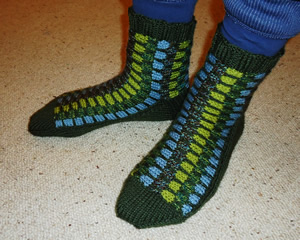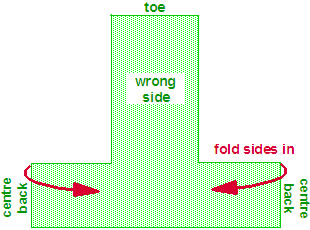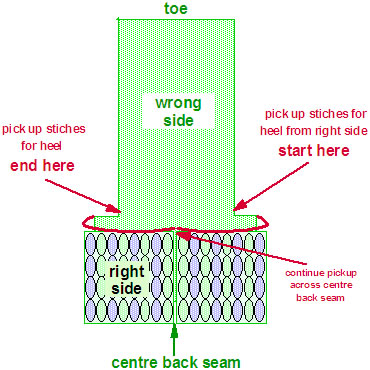Sideways Stash Socks

Father George: so fond of his bedsocks that they get worn out. [Since he is not bedridden I can only surmise he does not restrict their use to the bedroom!] Hence - by request - here are some more.
The patterned section of the sock is knitted sideways using a variation of a honeycomb stitch; it's an opportunity to use up really small amounts of double knitting yarn. I rotated 4 contrast colours but you could use a different colour for every set of rows; the key is to keep some consistency in the main colour.
Instructions.The first section of these socks is knitted sideways making a "T"
shape where the upright of the "T" is the upper foot, and the
cross bar curls around the leg to form the cuff, meeting at the back seam. First section (knit 2)Starting at the back leg seam, with main shade (M) cast on 23 sts on 2 needles and knit one row. Commence pattern. Join in contrasts (C1, C2 etc): Repeat rows 1-10 using different contrasts, once more. Next row(wrong side facing): Cast
on 40 sts, and then work across them and all sts, as for 1st row of pattern. [63sts] Continue to work the pattern on these 63 sts, working rows 1-10 three
times, and then rows 1-4. Next row(wrong side facing): Using main shade, cast off 40 sts, and purl across remainder. [23sts] Continue to work the pattern on these 23 sts, working rows 6-10, then
rows 1-10 once, times, and then rows 1-4. Second section (heel and sole).The remainder of the socks are worked entirely in the main shade. For the heel: with right side of the first section facing, oriented like an upside down "T" pick up 11 sts from each side of the instep:
Pick up and knit 11 sts from the left side first, ending at the cast on edge (which will be the centre back, and then turn the work over and bend round the second side, and pick up 11sts from the right side. The sock cuff now forms a circle with the back seams together, but not yet sewn.
Turn and purl 1 row across these 22 sts. Next row(right side facing): *
Sl1, k1, repeat from * to end. Repeat the last 2 rows 10 times more. Turn the heel: Next row: Sl1, k12, k2tog, k1. Turn. Continue to work short rows and decrease in this way until all sts have been incorporated. [14sts]. Next row(right side facing): Sl1,
k13, pick up and knit 13 sts down side of heel. Turn. Now work the instep decreases and sole: Next row: K1, sl1, k1, psso; knit
to last 3 sts, k2tog k1. Turn. Repeat the last 2 rows until 22 sts remain. Continue to work a further 50 rows to make the sole - upper and lower
foot sections should be about the same length. ToeNow we move to working in the round. Knit 11 sts on first double-pointed needle, 11sts on second, then with
right side facing, using third needle, pick up and knit 24 sts across
the toe edge of the first section. Next round: K1, sl1, k1, psso; knit to last 3 sts on third needle, k2tog k1. Complete the round by knitting the 11 sts on each of the first and second needles. [44 sts] Next round: K1, sl1, k1, psso; knit
to last 3 sts on third needle, k2tog k1; on first needle, k1, sl1, k1
psso; knit to end; on second needle, knit to last 3 sts, k2tog k1. Repeat the last 2 rounds until 16sts remain. Making upSew seams on each side of the sole, using a flat seam technique (not mattress stitch for example). Using double pointed needles and main shade, pick up 60-66 sts round top of sock and knit a k3/p3 rib for about 8 rows (or as long as you want), to form the welt. Cast off loosely. Sew in all ends. |
Materials2 x 50g balls of double knitting yarn, and a variety of left over DK colours. One pair and one set of four No 8 (4mm) needles, pointed at both ends. Tension22 stitches = 4ins Size mattersLength of foot, 9 inches (adjustable). AbbreviationsM is main shade (olive). sl1: slip the next stitch k2tog or p2tog: work 2 sts together to decrease. psso: pass the slipped stitch over, (also known as "ssk"; effectively you are "knitting 2 together through back loops") A Word
|


